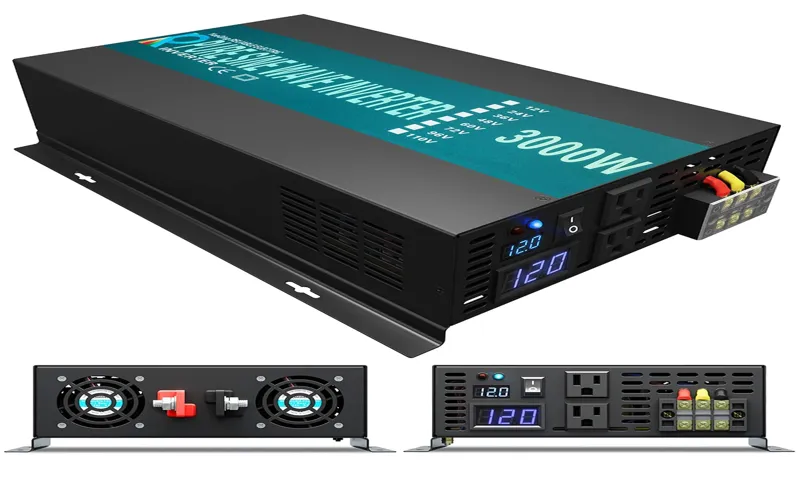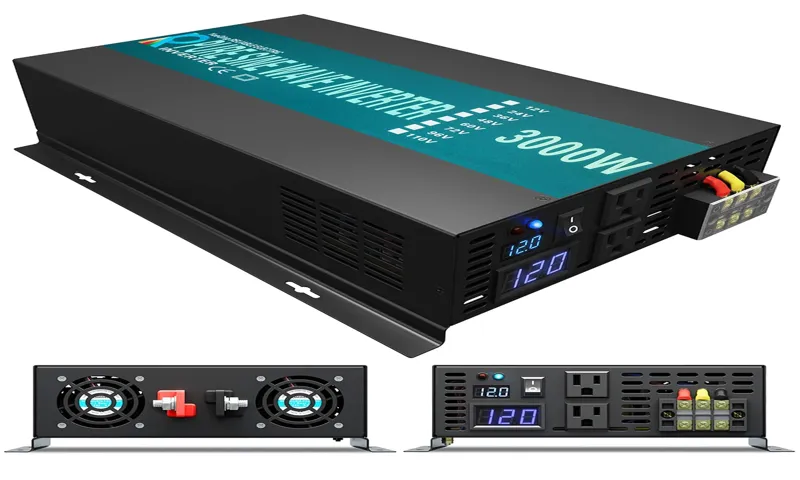Hey there! Have you ever wondered what exactly a power inverter is? Well, you’re in the right place! In this blog post, we’re going to dive into the wonderful world of power inverters and unravel their mysteries together. Imagine this scenario: you’re on a road trip in your beloved RV or camping in the great outdoors with your friends and family. But, alas, there’s no access to electricity, and your phone battery is on its last legs.
What do you do? Enter the power inverter, the hero of the situation! It’s like a magic box that can convert DC power from your battery into AC power, allowing you to plug in your electronic devices and charge them up. From laptops and smartphones to portable speakers and mini-fridges, a power inverter can power them all. Think of a power inverter as a translator between your car’s battery, which provides DC power, and your electronic devices, which require AC power.
It acts as a bridge, connecting the two worlds and allowing you to use your gadgets even when you’re far away from traditional power outlets. But how does it work, you may ask? Well, imagine flipping a switch to turn on a lightbulb. In a similar fashion, a power inverter takes the DC power from your battery and switches it back and forth at a rapid pace, creating a waveform that mimics AC power.
This waveform then powers your devices, giving them the energy they need to function. Now that you have a basic understanding of what a power inverter is and how it works, you may be wondering why it’s such a useful tool to have. Well, not only does it come in handy during camping trips and road adventures, but it’s also a lifesaver during power outages or in remote locations where electricity is scarce.
So, whether you’re a seasoned wanderer or just someone who wants to be prepared for any situation, a power inverter is a must-have gadget. It’s the key to staying connected and keeping your devices powered up, no matter where you are. In the upcoming posts, we’ll explore different types of power inverters, their features, and how to choose the right one for your needs.
So, stay tuned for more exciting information on this essential piece of technology!
Table of Contents
Definition and Function
What is a power inverter? Well, imagine you’re on a camping trip in the middle of nowhere, and you want to charge your smartphone or run a small appliance like a fan or a mini-fridge. But you don’t have access to electricity. That’s where a power inverter comes in handy.
A power inverter is a device that converts DC (direct current) power from a battery or a solar panel into AC (alternating current) power that can be used to run various electronic devices. It essentially changes the low voltage DC power to the higher voltage AC power that’s compatible with most household appliances. So, whether you need to power your laptop, charge your camera batteries, or even use a small kitchen appliance, a power inverter can be a lifesaver in situations where traditional power sources are not available.
Explanation of Power Inverters
power inverters Power inverters are devices that convert direct current (DC) electricity into alternating current (AC) electricity. This technology is essential in a variety of situations, such as when camping or during power outages, as it allows you to use AC-powered devices from a DC power source, like a car battery or a solar panel. Power inverters typically have multiple outlets, allowing you to plug in multiple devices simultaneously.
They come in various sizes and power ratings, ranging from small, portable inverters that can power a laptop or phone charger, to larger inverters that can run household appliances. In addition to converting DC to AC power, some inverters also provide additional features, such as USB ports for charging mobile devices or even built-in surge protection. If you’re looking to use electronic devices that require AC power in a location where only DC power is available, a power inverter is the perfect solution.

How Power Inverters Work
power inverters, function, definition, inverter, convert, DC to AC, electricity, electronic devices, backup power source, solar power systems, portable power supplies Power inverters are electronic devices that have a crucial function in our modern lives: converting direct current (DC) electricity into alternating current (AC) electricity. In simpler terms, they allow us to use our electronic devices that run on AC power, even when we only have access to DC power. Imagine being in a remote location with no electricity, but still being able to charge your phone or run your laptop.
That’s where power inverters come in handy. They serve as a backup power source, converting the DC power from sources like batteries, solar power systems, or portable power supplies into AC power that can be used to power appliances and devices. So, whether you’re on a camping trip, experiencing a power outage, or simply in need of a portable power solution, power inverters play a vital role in keeping us connected and powered up.
Types of Power Inverters
power inverters In simple terms, a power inverter is a device that converts direct current (DC) into alternating current (AC). It plays a crucial role in our daily lives, especially in situations where we need to use AC-powered devices or appliances but only have access to a DC power source. Power inverters are commonly used in a variety of settings, ranging from homes and vehicles to outdoor activities and emergency situations.
By converting DC power into AC power, power inverters enable us to run electronic devices such as laptops, televisions, and refrigerators, even when we’re off the grid or experiencing a power outage. They are incredibly versatile and essential gadgets that allow us to have access to our creature comforts even in unconventional circumstances. Whether you’re going camping, driving a recreational vehicle, or simply want a backup power source for your home, a power inverter can provide the necessary AC power to keep your devices running smoothly.
Common Applications of Power Inverters
power inverters, applications of power inverters
Choosing the Right Power Inverter
“What is a power inverter?” you may be wondering. Well, imagine this scenario: you’re on a long road trip and want to keep your laptop or other electronic devices charged. However, you don’t have access to a power outlet in your car.
That’s where a power inverter comes in handy. Essentially, a power inverter is a device that converts DC (direct current) power from your car’s battery into AC (alternating current) power, which is what most household devices use. This means you can plug in and use your electronics while on the go.
Power inverters come in various sizes and power capacities, so it’s important to choose the right one for your needs. Whether you just want to charge a phone or power a mini-fridge, there’s a power inverter out there that’s perfect for you. So, next time you’re planning a road trip or find yourself in need of portable power, consider investing in a power inverter to ensure you have the electricity you need.
Factors to Consider
power inverter, choosing the right power inverter
Calculating Power Needs
“power inverter” When it comes to choosing the right power inverter, there are a few key factors to consider. First and foremost, you’ll need to calculate your power needs. This involves determining how much power you’ll need to run the appliances and devices you plan to use with the inverter.
To do this, it’s important to consider both the constant power requirements and any short-term power surges that may occur. For example, a refrigerator may have a constant power requirement of 200 watts, but could have a surge requirement of 400 watts when the compressor kicks on. By taking these fluctuations into account, you’ll be able to choose an inverter that can handle your power demands without any issues.
Once you have a clear idea of your power needs, you can then focus on finding an inverter that meets those requirements. This can include considerations such as the inverter’s wattage capacity, the number and type of outlets it offers, and any additional features that you may find useful. By taking the time to calculate your power needs and research your options, you can ensure that you choose the right power inverter for your specific requirements.
Sizing the Power Inverter
power inverter, sizing, choose
Installation and Safety Tips
So you’ve heard the term “power inverter” being thrown around, but you’re not quite sure what it is exactly. Well, let me break it down for you. A power inverter is a device that converts direct current (DC) power into alternating current (AC) power.
In simpler terms, it takes the electricity from your car’s battery or a solar panel and turns it into the kind of power that can be used to run household appliances or charge electronic devices. Think of it as a translator for your electricity, converting it into a language that your appliances understand. So the next time you’re on a road trip and want to plug in your laptop or charge your phone, a power inverter will be your best friend.
Installing a Power Inverter
power inverter installation, safety tips, installing a power inverter So, you’ve decided to install a power inverter in your vehicle. Congratulations! This handy device can be a real game-changer, allowing you to power all sorts of electronics on the go. But before you start hooking things up, it’s important to understand the proper installation process and some safety tips to ensure everything goes smoothly.
First off, let’s talk about where to install your power inverter. Ideally, you’ll want to find a spot in your vehicle that is well-ventilated and away from any sources of moisture. This will help prevent any overheating or electrical issues.
It’s also a good idea to secure the inverter in place using screws or brackets to prevent it from moving around while you’re driving. Next, you’ll need to connect the inverter to your vehicle’s battery. Most inverters come with a set of cables that make this process relatively simple.
Just make sure you connect the positive cable to the positive terminal on the battery and the negative cable to the negative terminal. It’s important to make sure these connections are secure to prevent any loose wires or electrical shorts. Once the inverter is securely connected, you can start plugging in your electronics.
Keep in mind that power inverters come with different wattage ratings, so make sure you choose one that is capable of handling the electronics you plan to use. It’s also a good idea to periodically check the inverter and cables for any signs of wear or damage, as this can indicate a potential safety hazard. Now, let’s talk about some safety tips when installing a power inverter.
First and foremost, always make sure your vehicle’s engine is turned off before connecting or disconnecting the inverter. This will help prevent any accidental electrical shocks or damage to your electronics. Another important safety tip is to avoid using the inverter while your vehicle is in motion.
Safety Precautions
home security installation, home safety precautions, home security tips, safety measures, protect your home, burglar alarm, security systems, security cameras, motion sensor lights, door and window locks, security signage, avoid potential break-ins, peace of mind, security code, monitoring company, emergency response, home invasion, protect your family
Maintenance and Troubleshooting
When it comes to installing and maintaining any electrical system, safety should always be the top priority. Whether you’re a DIY enthusiast or hiring a professional, following safety protocols is crucial to prevent accidents and ensure a successful installation. One important tip is to always turn off the power supply before working with any electrical components.
This helps minimize the risk of electric shock or other injuries. Additionally, make sure to use insulated tools and wear protective gear such as gloves and safety glasses. It’s also crucial to follow manufacturer’s instructions and any local electrical codes to ensure a safe and compliant installation.
By taking these safety precautions, you can minimize the risks associated with electrical work and ensure the longevity and efficiency of your electrical system.
Conclusion
In conclusion, a power inverter is like a superhero for your electronics, magically transforming the language of electricity from direct current to alternating current. With the power to convert volts and hertz like a linguistic sorcerer, it brings harmony to the electrical symphony of your life. So, next time you find yourself in need of electricity in a foreign land, remember that with a power inverter in your arsenal, you have the power to conquer any electrical obstacle and save the day!”
FAQs
1. What is a power inverter and how does it work? A power inverter is a device that converts DC (direct current) power into AC (alternating current) power, allowing you to use electronic devices that typically run on AC power using a DC power source, like a car battery. It works by using electronic circuits to change the low voltage DC power into high voltage AC power, similar to what you would find in a standard electrical outlet. 2. What are the different types of power inverters available in the market? There are mainly three types of power inverters available: modified sine wave, pure sine wave, and square wave inverters. Modified sine wave inverters are the most common and affordable, but they may not be suitable for sensitive electronics. Pure sine wave inverters produce a clean and consistent wave output, making them ideal for all electronics. Square wave inverters are the least common and generate a choppy wave output, which is suitable for only a few applications. 3. What power rating should I choose for a power inverter? The power rating you choose for a power inverter depends on the total power consumption of the devices you plan to use simultaneously. It is recommended to choose an inverter with a power rating slightly higher than the total wattage of the devices to have some margin for power surges. 4. Can I use a power inverter to power my home appliances during a power outage? Yes, you can use a power inverter to power essential home appliances during a power outage. However, the power capacity of the inverter should be able to handle the total wattage of the appliances you want to power. It is also important to consider the runtime of the inverter and have a backup power source or extra batteries if needed. 5. Are power inverters safe to use? Power inverters are generally safe to use if used properly. It is important to follow the manufacturer’s instructions and safety guidelines. It is also recommended to use inverters with built-in safety features like overload protection, short circuit protection, and over-temperature protection. 6. Can I connect a power inverter directly to a car battery? Yes, you can connect a power inverter directly to a car battery to power electronic devices. However, it is important to ensure that the inverter is compatible with your car’s electrical system and the battery can handle the power requirements. It is also advisable to take necessary precautions and avoid draining the car battery excessively. 7. Can a power inverter damage electronic devices? If a power inverter is not properly designed or used, it can potentially damage electronic devices. Inadequate power quality, voltage spikes, or improper grounding can lead to malfunctions or even permanent damage to sensitive electronics. It is important to choose a high-quality inverter from a reputable brand and use it according to the manufacturer’s guidelines. 8. Are power inverters noisy? Power inverters can produce a slight humming or buzzing noise when in use. The noise level can vary depending on the type and quality of the inverter. Higher quality inverters often have noise-reduction features or fans to dissipate heat, which can also reduce noise. 9. Can I use a power inverter with solar panels? Yes, you can use a power inverter with solar panels to convert the DC power generated by the panels into usable AC power. In fact, solar inverters are specifically designed for this purpose and more commonly referred to as solar or PV inverters. 10. How do I maintain a power inverter? To maintain a power inverter, it is important to keep it clean and free from dust or debris that can obstruct ventilation. Regularly inspect the cables and connections for any signs of damage or wear. Additionally, it is recommended to perform routine battery maintenance, if applicable, and follow the manufacturer’s guidelines for storage and usage.



